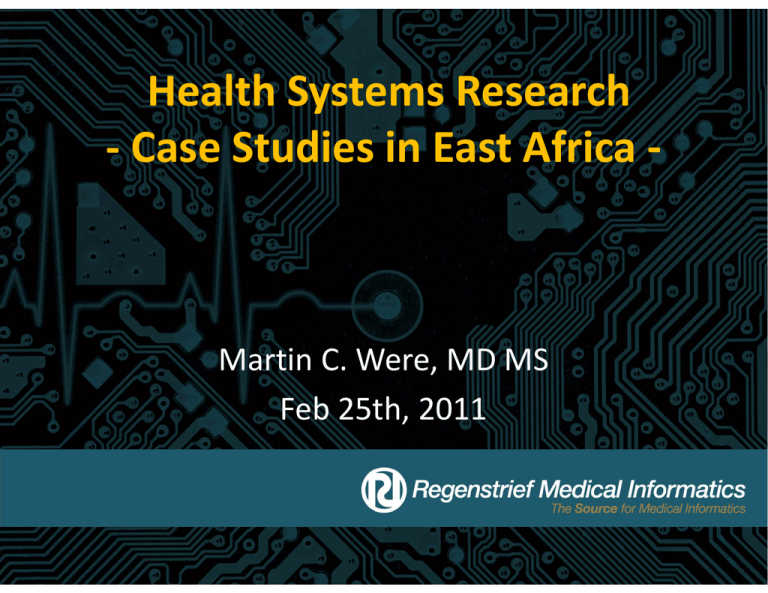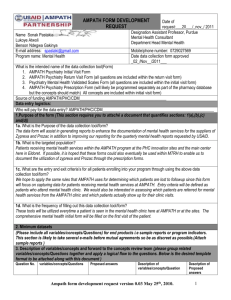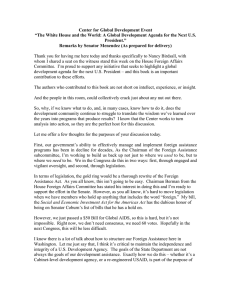
Health Systems Research
‐ Case Studies in East Africa ‐
Martin C. Were, MD MS
Feb 25th, 2011
1
Course Title
Health information systems to improve quality of care in resource poor settings.
2
Definition: Resource Poor Settings
• Economies are divided according to Gross National Income (GNI) per capita.
• Groups are (for 2011):
• Low income ‐ $995 or less
• Lower middle income ‐ $996 ‐ $3,945
• Upper middle income ‐$3,946 ‐ $12,195
• High income ‐ $12,196 or more.
3
‐ Country Classification Data | The World Bank
4
‐ Country Classification Data | The World Bank
5
‐ Country Classification Data | The World Bank
Definition: Quality of Care
"The degree to which health services for individuals and populations increase the likelihood of desired health outcomes and are consistent with current professional knowledge." ‐ Institute of Medicine (IOM) 6
Elements of Quality Care
• Recognize patients at risk for diseases.
• Do appropriate evaluation.
• Make the appropriate diagnosis.
• Start the appropriate treatment.
• Schedule the appropriate follow‐up. • Stimulate the appropriate adherence to treatment.
7
‐ Feld, S: What is the Definition of Quality Medical Care. Definition: Health IT
“The application of information processing involving both computer hardware and software that deals with the storage, retrieval, sharing, and use of health care information, data, and knowledge for communication and decision making.”
‐ Brailer & Thompson, 2004
8
Poor QoC in Resource‐Poor Settings
• Patients at risk for diseases are not being recognized. • Patients are not receiving the appropriate evaluation.
• Appropriate diagnoses are not being made.
• Patients are not being started on appropriate treatment.
• Patients not getting appropriate follow‐up.
9
QoC and Resources
• Good quality of care requires financial and human resources.
• Are the current resources being optimally used?
10
© World Health Organization (WHO). All rights reserved. This content is excluded from our
Creative Commons license. For more information, see http://ocw.mit.edu/fairuse.
11
Does HIT improve Quality of Care?
PLoS Med. 2011 Jan 18;8(1):e1000387.
Black A. D., et al. "The Impact of eHealth on the Quality and Safety of Health Care: A Systematic Overview."
3/R60HG 8, no. 1 (2011): e1000387. doi:10.1371/journal.pmed.1000387 CC-BY license 2.5.
12
eHealth Impact Review
“We found that despite support from policymakers, there was relatively little empirical evidence to substantiate many of the claims made in relation to these technologies. Whether the success of those relatively few solutions identified
to improve quality and safety would continue if these were deployed beyond the contexts in which they were originally
developed, has yet to be established. Importantly, best practice guidelines in effective development and deployment
strategies are lacking.”
‐ Black et al: PLoS Med. 2011 Jan 18;8(1):e1000387.
Black A. D., et al. "The Impact of eHealth on the Quality and Safety of Health Care: A Systematic Overview."
3/R60HG 8, no. 1 (2011): e1000387. doi:10.1371/journal.pmed.1000387 CC-BY license 2.5.
13
eHealth Impact Review ‐ Conclusion
‐ There is a large gap between the postulated and empirically demonstrated benefits of eHealth technologies. In addition, there is a lack of robust research on the risks of implementing these technologies and their cost‐effectiveness has yet to be demonstrated, despite being frequently promoted by policymakers and ‘‘techno‐enthusiasts’’ as if this was a given ‐
‐ Black et al: PLoS Med. 2011 Jan 18;8(1):e1000387.
Black A. D., et al. "The Impact of eHealth on the Quality and Safety of Health Care: A Systematic Overview."
3/R60HG 8, no. 1 (2011): e1000387. doi:10.1371/journal.pmed.1000387 CC-BY license 2.5.
14
HIT in resource‐poor settings
• Evidence is even more scarce in resource poor countries?
• Could resource‐poor countries benefit more from HIT interventions specifically because of they lack resources?
• We need to identify areas where HIT impacts quality of care (and where it does not).
• Impact on process and behavior ≠ Impact on outcomes.
• Need to evaluate the cost‐effectiveness of interventions.
15
Potential Roles of Health IT
• Help in understanding how health systems work.
• Help in improving how health systems work.
• HIT as a direct care intervention. 16
Understanding how care system works
• What problem are we trying to solve?
• How will the implemented technology impact care processes, experience, and workload?
• Example: WHO and Ugandan MoH wanted to know how EHRs will impact time‐use at two HIV clinics.
17
Uganda:
• Population: ~ 33 million
• Life expectancy: M 52 / F 54
• Mortality rate, infant (per 1000 live births) – 84.5
• GNI per capita – US $ 460
Source: CIA World Factbook (public domain image)
18
Patient Flow At Masaka ISS Clinic
© Taylor & Francis. All rights reserved. This content is excluded from our Creative
Commons license. For more information, see http://ocw.mit.edu/fairuse.
19
Measuring Time Use
• Work Sampling
• Interviews
• Self‐Administered Time Sheets
• Patient Flow Analysis Software (e.g. CDC PFA) • Time & Motion
‐ Bratt JH et al. A comparison of four approaches for measuring clinician time use. Health Policy & Planning 1999; 14(4): 374‐381
‐ Finkler SA et al. A comparison of Work‐Sampling and Time‐and‐Motion Techniques for Studies in Health Services Research. HSR 1993; 28(5): 576‐597
20
Subjects Observed
• Adult Patients (~ 80 returning pts, 20 new) for each
phase of study
• All primary care providers
• Registration / Records Department Staff
• Pharmacy
Only staff working a full‐shift were observed, each for 3 full workdays.
21
Patient and Provider Activities
• 4 days spent at each clinic identifying activities and developing categories.
• Programmed into HanDBase 3® software (DDH
Software, Inc., Wellington, Florida) on PDAs
• Tested using trained observers.
• Refined accordingly.
22
Sample Physician Tasks
Activity
Filing: Putting Documents in Record
Talking: Patient / Family
Exam: Pelvic Exam
Reading: Patient Chart
Writing: On Encounter Form
Break: Taking Break
Looking / Waiting: For Patient
Walking: Within Clinic
23
Analysis Group
Administrative
Direct Patient Care
Direct Patient Care
Indirect Patient Care
Indirect Patient Care
Personal
Waiting
Miscellaneous
Sample Patient Activities
Activity
Getting: Examined by Doctor
Getting: Individual Counseling
Getting: ART Medication
Looking for: Hospital Facility
Getting: Registered
Waiting: For doctor
Waiting: Laboratory
Analysis Group
Time With Physician
Time With Other Provider
Time With Pharmacy
Miscellaneous
Time With Registration
Waiting for Physician
Waiting for Other Provider
24
HanDBase
Microsoft Access
SAS
Data Collection
Data Aggregation
Data Analysis
Local PC
Images by MIT OpenCourseWare.
25
Local PC
Pre‐Implementation Results: PCPs
• Over 140 hours of PCP observation
Masaka
Mbarara
Mean hrs in Clinic
5.5 ± 1.3 (range 2.5–7.5 h)
4.9 ± 0.95 (range 3.8–6.5 h)
Clinic Start Time
8:56 am ‐ 10:57 am
8:15 am ‐ 9:53 am
Clinic End Time
12:32 pm ‐ 5:21 pm
12:27 pm ‐ 3:35 pm
Pts seen / Day
26 ± 8 (range 16 – 48)
29 ± 7 (range 19 – 41)
Mean pts / hour
3 – 8 patients
4 – 7 patients
26
Activities of PCPs (% of workday)
Masaka Providers
NP
CO
MD
NP+CO+MD
Mbarara Physicians
Indirect Patient Care
31.3 27.1 32.4
31.2
33.9
Direct Patient Care
26.2 33.3 27.4
28.2
25.1
Personal
20.9 15.7 17.9
18.1
16.0
Administrative
8.2 17.8 16.8
15.0
6.5
Waiting
7.0
1.4
3.0
3.6
1.4
Miscellaneous
6.5
4.8
2.6
3.8
17.0
Image by MIT OpenCourseWare.
27
Minutes per patient‐encounter spent by PCPs
Minutes per Pt Encounter (SD)
Masaka
Mbarara
p-Value
Indirect Patient Care
3.83 (2.84)
3.41 (2.41)
0.04
Direct Patient Care
3.41 (3.09)
2.51 (1.96)
<0.0001
Image by MIT OpenCourseWare.
‐ Indirect Patient Care: Reading or Writing on patient’s chart or encounter form, prescribing medications, discussing patient’s care on phone or with other providers.
‐ Direct Patient Care: Talking to or counseling patient(s), and examining or doing a procedure on patient.
28
Results for Established Patients
• Over 420 hours of patient observation
Masaka
Mbarara
Daily Patient Census
119 ± 34 (range 71 –
197)
107 ± 45 (range 62 –
172)
Mean Visit Length
77 ± 38 minutes
196 ± 84 minutes
29
Inefficient Systems of Care:
Patient Activity
Waiting
Time with other staff
Time with clinicians
Miscellaneous
Time with pharmacy
Mean (median) minutes per visit
Masaka
Mbarara
51 (43)
122 (123)
11 (5.0)
43 (27)
7.5 (6.3)
8.2 (6.1)
5.8 (3.5)
23 (16)
2.6 (1.9)
1.7 (1.4)
30
Discussion
• PCPs spent a limited amount of time in clinic
• While in clinic 40% of time not spent on tasks related to patient visits
• Some Suggestions: –Alleviate other responsibilities outside the clinic.
– Re‐assign tasks so that time is spent on tasks PCPs are uniquely qualified.
– Re‐engineer work processes. Example: Encounter Forms vs. Free Text Notes.
31
Discussion
• Large part of clinic visit spent by patients Waiting.
– Time & Motion Data gives you information on possible bottlenecks.
• Large variability:
– In start‐ and end‐times and clinic length for providers
– In daily patient census.
32
Discussion
• Need better queue management in this multiple stage system
• Take advantage of the waiting time – e.g. to educate and counsel patients
• “Assign responsibility to patient flow problem” –
Eugene Litvak
• Manage patient daily census better
• Large variability:
– In start‐ and end‐times and clinic length for providers
– In daily patient census ‐ ? Scheduling system.
33
Impact of EHRs on Time Use
34
Courtesy of OpenMRS. Used with permission.
OpenMRS Implementations
Overlay courtesy of OpenMRS. Used with permission.
Map © Google. All rights reserved. This content is excluded from our Creative
Commons license. For more information, see http://ocw.mit.edu/fairuse.
35
EHRs with Clinical Summaries
36
Results of Mbarara Time-Motion Study: Providers*
Before After Before–After Measure
Summaries
Summaries
Difference
Number of physicians
3
3
0
Number of clinic hrs/day
6.5
6.4
–0.1
Number of patients/day
41
44
3
25.7
34.6
8.9
Direct patient care (%)
35.6
33.2
–2.4
Indirect patient care (%)
6.0
8.8
2.8
Administration (%)
14.5
13.3
–1.2
Personal (%)
16.7
6.6
–10.1
Miscellaneous (%)
3.4
2.0
Waiting (%)
1.4
* Time is measured in percent of a provider’s workday. No between
group differences were statistically significant (p-value <0.05)
37
Minutes (mean) spent by providers per patient encounter
Activity
Direct patient carea
Indirect patient careb
Before
After
Summaries Summaries
N = 237
N=395
2.3
2.9
3.2
2.9
P-Value
< 0.001
0.7
a Direct Patient Care: Tasks include talking to or counseling patient(s), and examining or doing a procedure on patient.
b
Indirect Patient Care: Tasks include reading clinical summary or patient’s chart, writing on encounter form or chart, prescribing medications, discussing patient’s care on phone or with other providers.
Were MC, Shen C, Bwana M, Emenyonu N, Musinguzi N, Nkuyahaga F, Kembabazi A, Tierney WM. Int J Med Inform. 2010;79(2):90‐6.
38
Table 6: Results of Mbarara Time-Motion Study: Patients*
Before
After
Difference
Measure
N = 88
N = 94
–0.2
Time in registration
1.2
1.0
–0.7
Time with clinicians
7.7
6.4
+19.0
Time with other staff
42.3
61.3
+9.9
Time with pharmacy
1.7
11.6
–5.0
Miscellaneous activities
22.9
17.9
–33.9
Waiting
121.9
88.0
–0.3
Waiting for registration
0.3
0.0
–0.6
Waiting for clinicians
45.1
44.5
– 23.5
Waiting for other staff
52.4
28.9
–9.5
Waiting for pharmacy
24.1
14.6
–11.5
Total visit time
197.7
186.2
* Time in mins / visit. observed. p-value <0.05 indicated by shading.
39
40
Considerations:
• What implementation models work well to reduce human‐
resource constraints and cost burden? • What is the effect of the EHRs on how clinics function?
• Can we assess the impact of these systems on patient care?
41
Implementation Model
‐ Were MC, Emenyonu N, Achieng M, Shen C, Ssali J, Masaba JP, Tierney WM. “Evaluating a scalable model for implementing electronic health records in resource‐
42
Clinical Decision Support:
Hypothesis:
EHRs‐based reminders to clinicians can improve quality of care, compliance with guidelines, and patient safety in developing countries.
Element of QoC:
Do appropriate evaluation for patients.
43
44
Courtesy of USAID/AMPATH. Used with permission.
Courtesy of USAID/AMPATH. Used with permission.
Adrian Gardner
Webuye AMPATH Clinic
45
Courtesy of USAID/AMPATH. Used with permission.
46
Courtesy of USAID/AMPATH.47Used with permission.
Courtesy of USAID/AMPATH. Used with permission.
48
Please order CD4 count now (last CD4 ordered over 12 months ago)
Courtesy of USAID/AMPATH. Used with permission.
49
Why CDSS can fail in this setting:
• Unreliable generation of summaries & reminders
‐ Poor infrastructure: power, printers, viruses.
‐ nurses too busy to print summaries.
• Inaccurate reminders
‐ Lab results in paper but not in EHRs.
‐ Errors on encounter forms, and with data‐entry.
‐ Delayed data entry.
• Providers ignoring accurate reminders
‐ Rote practice patterns or unaware of approved guidelines.
‐ Noormohammad SF, Mamlin BW, Biondich PG, McKown B, Kimaiyo SN, Were MC. IJMI 2010;79(3):204‐10.
50
Clinical Summaries with Reminders
• Clinical summaries with reminders available to >50,000 AMPATH patients (21 sites) at the time of visit.
• Include Adult HIV, Pediatric HIV, and Antenatal Care summaries.
• > 30 Adult and Pediatric reminders currently implemented.
• Work supported by Abbott Fund.
51
Impact of computer‐generated care suggestions on compliance with CD4 testing algorithms
70
63
60
Before reminders
After reminders
% compliance
50
42
40
36
38
30
20
10
0
Control Clinic
Intervention
52
Clinic
Were MC, Shen C, Tierney WM, Mamlin JJ, Biondich
PG, Li X, Kimaiyo S, and Mamlin BW. JAMIA 2011.
Elements of Quality Care
• Recognize patients at risk for diseases.
• Do appropriate evaluation.
• Make the appropriate diagnosis.
• Start the appropriate treatment.
• Schedule the appropriate follow‐up. • Stimulate the appropriate adherence to treatment.
53
Elements of Quality Care
• Recognize patients at risk for diseases.
• Do appropriate evaluation.
• Make the appropriate diagnosis.
• Start the appropriate treatment.
• Schedule the appropriate follow‐up. • Stimulate the appropriate adherence to treatment.
54
10%
90%
Only 12% of men and 10% of women in sub‐Saharan Africa
know their HIV‐status.
55
• USAID‐AMPATH’s home visit program:
‐ Visit all 2 million individuals in catchment area.
‐ Collect basic health information.
‐ Offer focused care services.
• Typically, records collected during such visits could have been paper‐based.
• Hypothesis: We can completely leapfrog paper‐based records, and create electronic health records (EHRs) for each home‐
based clinical visit.
56
• Goals of Home Visits:
‐
‐
‐
‐
‐
‐
‐
‐
‐
‐
Identify HIV‐positive pts unaware of their status.
Offer care services to identify patients as needed.
Identify pregnant women not receiving antenatal care.
Identify orphaned and vulnerable children.
Identify children without appropriate immunizations.
Identify individuals at risk for TB.
Provide rapid HIV testing.
Sputum testing for TB.
Provide de‐worming medications.
Provide bed nets to families.
57
• Developing Handheld Program:
‐ Engaged stakeholders.
‐ Identified data elements to be collected.
‐ Understood workflow and testing algorithms.
58
Household Information
Courtesy of USAID/AMPATH. Used with permission.
59
HIV Module
Courtesy of USAID/AMPATH. Used with permission.
60
TB Module
Courtesy of USAID/AMPATH. Used with permission.
61
Palm T|X and Garmin e‐trex Devices
Photo showing connected devices removed due to copyright restrictions.
62
Community Mobilization
Courtesy of USAID/AMPATH. Used with permission.
63
HCT Counselors
Courtesy of USAID/AMPATH. Used with permission.
64
Door‐To‐Door HCT
Courtesy of USAID/AMPATH. Used with permission.
65
HCT Counseling
Courtesy of USAID/AMPATH. Used with permission.
66
HCT Testing
Courtesy of USAID/AMPATH. Used with permission.
67
HCT Testing
Courtesy of USAID/AMPATH. Used with permission.
68
HCT and Handheld Technology
Courtesy of USAID/AMPATH. Used with permission.
69
Results:
• Jul‐Oct 2008: ‐ 93 CHWs visited 14,648 households.
‐ 40,111 people (55% female, 26% < 13 years old) had electronic records created. ‐ 403 of 899 (45%) pregnant women identified were not receiving antenatal care. ‐ 1,131 HIV+ pts identified. 693 (61.3%) were new diagnoses.
‐ 376 individuals had been exposed to or had symptoms suggestive of tuberculosis – sputum samples collected. 70
Cost of Technology:
‐ 2 million tested in 3 yrs (2,565 / day in 780 workdays).
‐ 320 sets of PDA/GPS devices @ $573 per set.
Item
Cost
320 GPS/PDA/Cable Devices/Pendragon Licenses $183,360
18 PCs @ $1,500 each $27,000
Programming time 1‐month
$1,500
IT person (50% FTE) for 3 yrs $22,000
Data Assistants (2 FTEs) for 3 years $45,000
Data Manager (50% FTE) for 3 years $22,000
Training on technology for counselors & HCT staff
$1,000
TOTAL $301,860
71
Cost of Technology:
‐ With PDA/GPS ‐ $301,860 for 2 million people. $0.15 per individual seen or per record created by CHW.
Compare to:
‐ Manual data entry:
Current pay is $17 / day to enter ~ 80 encounter forms. $0.21 per encounter form entered.
72
Improving Technology
+
+
Built Open‐Source HCT software (ODK). • Use single device with GPS, bar‐coding, and camera.
• HCT data stored in an instance of OpenMRS.
• Providing ‘Universal’ IDs during HCT.
•
73
Nothing is Easy
Courtesy of USAID/AMPATH. Used with permission.
74
Bringing Care to Individuals
Courtesy of USAID/AMPATH. Used with permission.
75
Improving Access & Awareness
Courtesy of USAID/AMPATH. Used with permission.
76
Five‐Stage Framework for Evaluation of HIT Projects
(1) Problem definition.
(2) Bench testing in the laboratory.
(3) Early field trials under the direct control of the original investigator. (4) Field testing in new or unfamiliar settings.
(5) Definitive study of the system’s efficacy during routine operational use.
‐ Stead WW, Haynes RB, Fuller S, et al. Designing medical informatics research and library‐‐resource projects to increase what is learned. J Am Med Inform Assoc 1994;1(1):28‐33
77
Thank you.
78
Country
Australia Canada Germany
New
Zealand
Britain
United
States
Overall ranking (2007)
3.5
5
2
3.5
1
6
Quality of care
4
6
2.5
2.5
1
5
Access
3
5
1
2
4
6
Efficiency
4
5
3
2
1
6
Equity
2
5
4
3
1
6
Healthy lives
1
3
2
4.5
4.5
6
$2,083
$2,546
Health expenditures
per capita (2004)
$2,876*
$3,165
$3,005*
$6,102
*2003 data; Source: The commonwealth fund
Image by MIT OpenCourseWare. Source: The Commonwealth Fund. * 2003 data.
79
Masaka Clinic Mbarara Clinic
• Funded by Uganda National AIDS control Program
• Funded by Uganda National AIDS control Program
• 5,100 HIV +ve patients
• 11,000 HIV +ve patients
• Care by MDs, Nurse Practitioners and Clinical Officers (CO).
• Care by MDs only.
• Structured paper‐based encounter forms with coded answers used
• Hand‐written free‐text paper records
• No patient scheduling system
• No patient scheduling system
80
MIT OpenCourseWare
http://ocw.mit.edu
HST.S14 Health Information Systems to Improve Quality of Care in Resource-Poor Settings
Spring 2012
For information about citing these materials or our Terms of Use, visit: http://ocw.mit.edu/terms.
81







